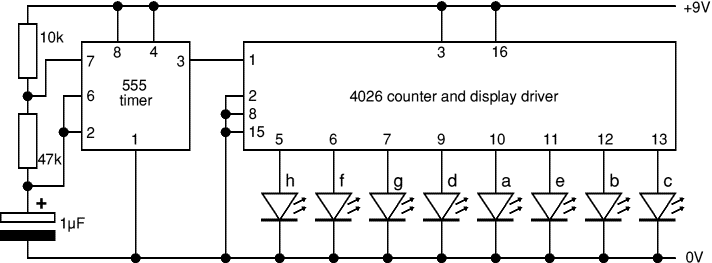
Random Flasher for 8 LEDs Project

This project flashes eight LEDs in a seemingly random manner. It utilizes a 4026 combined counter and display driver integrated circuit (IC) designed for driving 7-segment LED displays. The sequence is not entirely random, as seven of the LEDs represent the display segments, while the eighth LED is controlled by an output typically used for driving additional counters. A table is provided to illustrate the LED sequence, and users have the option to utilize fewer than eight LEDs based on their requirements. The project employs a 555 astable circuit to generate clock pulses for the 4026 counter. Resistors are unnecessary for the LEDs since the 4026 IC regulates the current to approximately 5mA for each LED.
The circuit operates by utilizing a 4026 integrated circuit, which serves as both a counter and a display driver. This IC is particularly well-suited for applications involving LED displays, as it can control multiple segments efficiently. In this setup, the 4026 counts clock pulses generated by a 555 timer configured in astable mode. The 555 timer produces a continuous square wave output, which serves as the clock signal for the 4026, facilitating the sequential illumination of the LEDs.
The arrangement of the LEDs corresponds to the outputs of the 4026, where each output pin drives an individual LED. The design allows for flexibility, enabling the user to select a subset of the eight LEDs based on the desired visual effect or application requirements. The current limiting feature of the 4026 eliminates the need for external resistors, simplifying the circuit design and reducing component count.
In terms of functionality, the project can be further enhanced by modifying the frequency of the clock signal generated by the 555 timer, which would affect the speed of the LED flashing sequence. Additionally, the user may implement further logic to control the pattern or timing of the LED sequences, providing an opportunity for creative modifications. The schematic would include the 4026 connected to the 555 timer, with the output pins of the 4026 linked to the respective LEDs, ensuring a clear and organized layout for effective circuit operation.This project flashes eight LEDs in an apparently random manner. It uses a 4026 combined counter and display driver IC which is designed for driving 7-segment LED displays. The sequence is not really random because seven of the LEDs would normally be the display segments, the eighth LED is driven by an output that is normally used for driving furth
er counters. The table below shows the sequence for the LEDs. You can use less than eight LEDs if you wish and the table may help you decide which ones to use for your purpose. This project uses a 555astable circuit to provide the clock pulses for the 4026counter. Resistors are not required for the LEDs because the 4026 IC limits the current to about 5mA for each LED.
This website does not collect any personal information unless you contact me by email. If you send me an email your name, email address, and any other personal information you supply will be used only to respond to your message. Your personal information will never be given to any third party without your permission. This website displays affiliate advertisements. If you click on these advertisements the advertiser will know you came from this site and I may be rewarded if you become their customer.
No personal information is passed to advertisers. This website uses StatCounter cookies to estimate the number of unique visitors. No personal information is stored in the cookies. If you would like further information or wish to refuse these cookies please visit the StatCounterwebsite. 🔗 External reference
The circuit operates by utilizing a 4026 integrated circuit, which serves as both a counter and a display driver. This IC is particularly well-suited for applications involving LED displays, as it can control multiple segments efficiently. In this setup, the 4026 counts clock pulses generated by a 555 timer configured in astable mode. The 555 timer produces a continuous square wave output, which serves as the clock signal for the 4026, facilitating the sequential illumination of the LEDs.
The arrangement of the LEDs corresponds to the outputs of the 4026, where each output pin drives an individual LED. The design allows for flexibility, enabling the user to select a subset of the eight LEDs based on the desired visual effect or application requirements. The current limiting feature of the 4026 eliminates the need for external resistors, simplifying the circuit design and reducing component count.
In terms of functionality, the project can be further enhanced by modifying the frequency of the clock signal generated by the 555 timer, which would affect the speed of the LED flashing sequence. Additionally, the user may implement further logic to control the pattern or timing of the LED sequences, providing an opportunity for creative modifications. The schematic would include the 4026 connected to the 555 timer, with the output pins of the 4026 linked to the respective LEDs, ensuring a clear and organized layout for effective circuit operation.This project flashes eight LEDs in an apparently random manner. It uses a 4026 combined counter and display driver IC which is designed for driving 7-segment LED displays. The sequence is not really random because seven of the LEDs would normally be the display segments, the eighth LED is driven by an output that is normally used for driving furth
er counters. The table below shows the sequence for the LEDs. You can use less than eight LEDs if you wish and the table may help you decide which ones to use for your purpose. This project uses a 555astable circuit to provide the clock pulses for the 4026counter. Resistors are not required for the LEDs because the 4026 IC limits the current to about 5mA for each LED.
This website does not collect any personal information unless you contact me by email. If you send me an email your name, email address, and any other personal information you supply will be used only to respond to your message. Your personal information will never be given to any third party without your permission. This website displays affiliate advertisements. If you click on these advertisements the advertiser will know you came from this site and I may be rewarded if you become their customer.
No personal information is passed to advertisers. This website uses StatCounter cookies to estimate the number of unique visitors. No personal information is stored in the cookies. If you would like further information or wish to refuse these cookies please visit the StatCounterwebsite. 🔗 External reference





